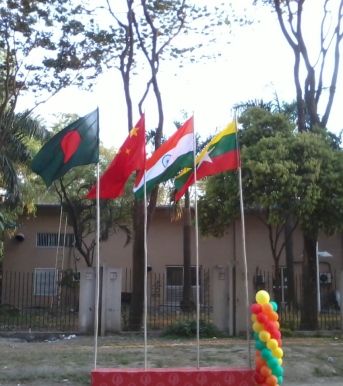This is an updated version of a presentation made at Session II: Strengthening Multi-modal Connectivity, 11th BCIM (Bangladesh, China, India and Myanmar) Regional Cooperation Forum, Dhaka, Bangladesh, 24 February 2013.
The objective of this presentation is to draw some lessons for the implementation of physical connectivity infrastructure projects in underdeveloped areas within the BCIM sub-region using experiences from some ongoing infrastructure projects in the region.
1. Objectives of Connectivity
At the outset it is important to define what physical connectivity will achieve. ‘Economic development’ is an objective, certainly but the expression can mean different things to different constituents. Ordinarily, better roads and improved telecom connectivity lead to increases in the volume of trade, the movement of labour and so on. However, in the absence of a rational policy on and/or management of border trade for example, better roads will only increase the volume of illegal/informal trade. This does not help the authorities in increasing revenues in the form of tax collections and therefore, in getting adequate returns on investments made in developing physical infrastructure.
Similarly, if accessibility from major economic centres to the border regions were to increase, market sizes would also naturally increase but this brings in more players and therefore, competition increases. Will vested interests in the local economy be open to such competition? And given the local political economy, might this in turn lead to delays in implementation, poor maintenance, etc.?
Large physical infrastructure projects in sparsely-populated and minority-dominated border areas often requires the presence of ‘outsiders’, in the form of skilled and unskilled labourers. This can often lead to tensions between the locals and outsiders, and depending on the nature of local governing structures, one or the other side can dominate exchanges and hold project implementation to ransom and sometimes literally so. Such concerns over ‘outsiders’ have been expressed by local interest groups in Arunachal over the arrival and possible increase in the numbers of labourers involved in building of the state’s numerous planned dams. Northeast India has in the past, seen several instances of kidnapping of or extortion from labourers, government servants or businessmen from other parts of the country. These have as much to do with economic interests as they have to with ethnic identity issues.
These examples highlight the need not just for clarity about objectives, but to consider carefully and prepare adequately for their consequences. In the latter regard, governments, usually in this case the central governments must acknowledge local interests and be able to bring them on board in a democratic and ultimately, sensitive manner.
2. Centre-Local Coordination
This brings us to the next point about the nature of interaction, including feedback, and coordination between governments at the national and local levels and indeed, within governments themselves.
In a large federal polity like India, it is inevitable that there will be issues of coordination arising simply from the nature of geography and the scale of operations. That said, some problems can arise because of lack of agreement on how the objectives are to be implemented – a conflict between the Ministry of Road Transport and Highways and the Ministry of Environment and Forests in India is playing out even as we speak.
But there is also the larger issue of lack of an alignment of objectives often usually between the ministries that deal with trade and commerce and diplomacy on the one side and those that supervise the security agencies. Naturally, the latter are wary of the security implications of freer trade and the movement of people across borders and not without reason for borders in the region are known for a general lack of administration, providing havens for insurgent groups, and as sites for gun-running, narcotics smuggling and human trafficking. But the latter agencies also use ‘security’ as a blanket cover for lack of resources and/or capacity to monitor and manage the borders. Nowhere, is this most strongly the case than in India’s Northeast and in Myanmar. In both instances, the central government’s inability to eliminate or control the activities of insurgent groups has put paid to hopes of opening up several important cross-border trade routes.
Not only are their issues of coordination at the central government level, but between central and local governments too. For instance, the Kaladan project on the Indian side has faced several difficulties including the stoppage of work, owing to issues arising out of land acquisition. The aforementioned central government Ministry of Road Transport and Highways has provision for compensation for the owners of private land through which the project runs. However, the issue at the local level is two-fold. One, there is the claim that jhoom land which is also a source of livelihood for the local populace has been classified as forest land and hence there is no compensation available. Two and related, there are multiple claimants for the same piece of land or for land that was previously unclaimed until the road alignment was declared, suggesting the collusion of local authorities in the making of fake pattas/LSCs (land settlement certificates).[1]
While, this suggests a general failure in planning and of foresight, there is a further complication in the case of the Kaladan project brought about by the fact that administrative arrangements in the project area fall under a tribal district council that is autonomous in many respects from the state government in Mizoram under the provisions of the Sixth Schedule of the Indian Constitution. This includes control over forests and over land and revenue, for instance. Thus, the complexity of local administrative arrangements needs to be factored in and add to this the need to coordinate also with a foreign government, in this case the government of Myanmar.
3. Other Variables
Even with complete agreement among all parties concerned, and often because of it, there are several issues that are left unaddressed, often out of convenience. Environmental considerations are one such issue. Especially, in poor and poorly-represented (in the national mainstream) regions and communities, there can be a tendency to brush aside or run roughshod over accountability mechanisms that are implemented elsewhere in the country or at the international level. This is the case, in many projects involving Northeast India, particularly in the case of Arunachal Pradesh’s many dams where environmental impact assessments have often been given the go-by or where local communities have understood the purpose of hearings and public meetings in this regard and have blocked them, so that these do not simply end up as formalities that the government can cite to give the green light to projects.
Then there is the issue of border security and management. While central government agencies can be extremely conservative when it comes to security issues – indeed, this has held up border areas development in parts of the BCIM region for decades – there is now a greater openness to considering the security benefits of development projects and thus moving past traditional fears and concerns. Thus, even as there is an acknowledgement that economic development must take priority, there can on occasion be a tendency to swing to the other extreme and to declare that certain problems will be inevitable and that these must be taken in the stride. What such an attitude actually displays is, is an excuse for the lack of proper planning or the lack of capacity to implement proper monitoring mechanisms (in the case of say, stemming the flow of narcotics across borders) or an unwillingness or inability to deal with vested interest groups (say, in the case of informal trade). Sections of the Indian central government now seeking to push through big-ticket infrastructure projects often ignore the case of Yunnan where open or porous borders have also seen continued flow of arms and narcotics across the Sino-Myanmar borders and of late, even the flow of refugees following conflict on the Myanmar side. Meanwhile, Moreh in Manipur, India’s most developed official trading point on the border with Myanmar continues to be the site of massive smuggling, including of narcotics.
Seamless connectivity also requires a harmonization of rules and regulations. To proceed without such harmonization is to place the cart before the horse. Therefore, the BCIM countries will need to plan adequately, including in the form of enacting national legislation, entering into treaty obligations, so as to implement infrastructure connectivity projects without simultaneously creating cause for conflict on the ground.

The challenges posed by this aspect of connectivity are evident when one considers the fact that even in the case of the Greater Mekong Sub-region (GMS) – often held up as a model of successful sub-regional economic cooperation – there are huge challenges of trade and transport facilitation despite the progress in developing the actual physical transport infrastructure itself. For instance, Bangladesh and Myanmar, to take the case of the BCIM, still do not have any provision for regular banking services with each other. In Mizoram, meanwhile, while the land customs station at Zokawthar on the border with Myanmar has an authorized State Bank of India (SBI) branch, this branch has no authority to conduct foreign exchange transactions. It is only the SBI branch in Champhai, 27kms away from the border that has permission to do so. But even here, there are at the moment no foreign exchange transactions because the bank has been unable to find qualified personnel to carry out the task. Logistics costs thus, continue to remain high affecting overall economic viability.
The question of sustained and sustainable financing for infrastructure projects is no less a challenge. Once again the GMS experience is instructive. Both the maintenance and improvement of existing physical infrastructure has run into problems due to lack of adequate financial resources. This situation is also mirrored in many parts of Northeast India, where roads built with international funding have been poorly maintained once responsibility for maintenance was transferred to local government authorities, even granting that lack of resources might not be the only reason.
Conclusion
Strengthening connectivity in the BCIM region with its mix of underdevelopment, rapid economic growth and huge potential for economic and social transformation will require careful attention to the aspects just highlighted. These considerations must guide not just planning of national projects but also of cross-border projects which surely must increase in number and scale in order for the BCIM to both gain additional substance and deepen its institutionalization.
[1] In fact a study by the NGO, PRISM in Mizoram has through the use of the Right to Information established that the sum total of land holdings calculated from government data amounts to 453,446,533.200 sq.km. while the total area of the entire state is actually only 21,080.000 sq. km. The vast majority of the discrepancy occurs in the LSCs (1,610,985.600 sq. km.) and periodic pattas (451,808,352.714 sq. km) issued by Mizoram’s Revenue Department.

